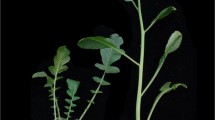Abstract
Analysis of flowering in diallel crosses involving seven varieties of peas has shown that a simple polygenic system is primarily responsible for the control of flowering, with a major gene (Sn) or effective factor which delays flowering and whose effect is increased during short days. Since there was no evidence of transgressive segregation, the use of this material in a breeding programme would not be expected to provide new varieties significantly earlier or later flowering than their parents. The development of earlier and later flowering varieties will most probably depend on the discovery of parents where a different relationship exists between node of flowering and time of flowering from that discovered during the investigation.
Similar content being viewed by others
References
Barber, H. N. (1959). Physiological genetics ofPisum. II. The genetics of photoperiodism and vernalisation.Heredity 13:33–60.
Dickinson, A. G. &J. L. Jinks (1956). A generalised analysis of diallel crosses.Genetics 41:65–78.
Hayman, B. I. (1954). The theory and analysis of diallel crosses I.Genetics 39: 789–809.
Hayman, B. I. (1958). The theory and analysis of diallel crosses II.Genetics 43:63–85.
Housley, S., B. Curry &D. G. Rowlands (1961). A growth room for plant research.J. Agric. Eng. Res. 6:203–216.
Jinks, J. L. (1954). The analysis of continuous variation in a diallel cross ofNicotiana rustica varieties.Genetics 39:767–788.
Jinks, J. L. (1956). The F2 and backcross generation from a set of diallel crosses.Heredity 10:1–30.
Kribben, F. J. (1955). Zu den Theorien des Photoperiodismus.Beitr. Biol. Pflanzen 31:297–311.
Lang, A. (1948). Genetik der Vernalisation und des Photoperiodismus, in:Vernalisation and Photoperiodism. Ed. A. E. Murnek & R. O. Whyte.Chronica Botanica, Waltham, Mass.
Purvis, O. N.: (1939): Studies on vernalisation in cereals V. The inheritance of the spring and winter habit in hybrids of Petkus rye.Ann. Bot. N.S.3:719–729.
Sarkar, S. (1958). Versuche zur physiologie der Vernalisation.Biol. Zentralbl. 77:1–49.
Wellensiek, S. J. (1925). Genetic monograph onPisum.Bibl. Genetica 2:343–476.
Author information
Authors and Affiliations
Rights and permissions
About this article
Cite this article
Rowlands, D.G. Genetic control of flowering inpisum sativum L.. Genetica 35, 75–94 (1964). https://doi.org/10.1007/BF01804876
Received:
Issue Date:
DOI: https://doi.org/10.1007/BF01804876




